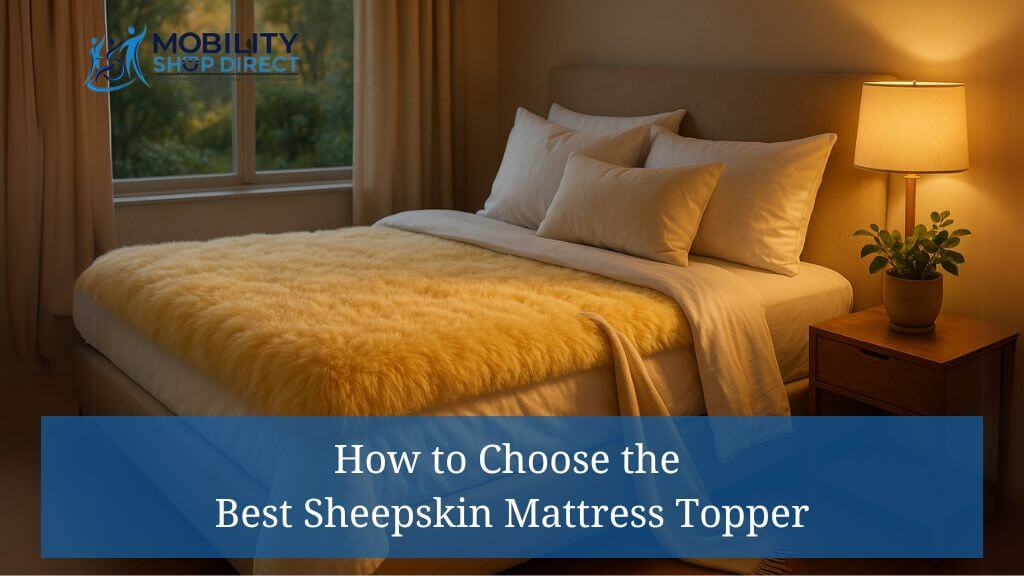Is your bed as cozy and supportive as it could be? If you’re waking up with back pain, tossing and turning from overheating, or just want a little more comfort, it might be time to rethink your setup; starting with your mattress topper. Sheepskin mattress toppers aren't just for show. They’re practical, durable, and can seriously improve your sleep quality. But not all sheepskin toppers are the same, and picking the right one makes all the difference.
This guide walks you through everything you need to know; from sheepskin vs. wool, to thickness and care tips. You’ll learn how sheepskin helps regulate temperature, why it’s a good pick for sensitive sleepers, and how to keep it looking and feeling great.
Let’s dive into what makes a sheepskin mattress topper such a smart choice.
Table of Contents
Understanding the Benefits of Sheepskin Mattress Toppers
Why Choose a Sheepskin Mattress Topper?
Think of sinking into a cloud every night. That’s what a sheepskin mattress topper can feel like. Its soft texture cushions your body and eases pressure points, which helps you sleep more soundly and wake up feeling better.
Sheepskin naturally wicks away moisture and keeps air flowing, which means fewer disruptions from getting too hot or too cold at night. This quality makes it great for year-round use. And because it contours without sinking too far, it offers support that can help with back pain or joint stiffness.
If you’re still deciding whether sheepskin is right for you, it helps to compare it directly to wool.
Sheepskin vs Wool: Which One is Right for You?
Sheepskin is known for its silky texture and soft feel. It offers a plush sleeping surface that keeps its shape over time. If softness is a top priority, sheepskin wins.
Wool toppers are firmer and usually thicker. They still regulate temperature well, but they feel denser and don’t hug the body as much. If you like a flatter, more structured sleep surface, wool might suit you better.
Ultimately, it comes down to comfort. This comparison guide breaks down the differences even further if you want help choosing.
Key Factors to Consider When Choosing the Right Sheepskin Mattress Topper
1. How to Choose the Ideal Thickness and Density
Medium thickness with high density usually strikes the best balance between soft comfort and solid support. It’s firm enough to help with posture, but still cozy. If you’ve got back or joint pain, a thicker and denser topper may give you the relief you need.
If you're just looking for added softness without much change in firmness, a thinner topper will do the job. This guide breaks down how thickness affects feel and performance.
2. The Role of Temperature Regulation Properties
Sheepskin is breathable and moisture-wicking. If you deal with night sweats or tend to sleep hot, that matters. It keeps your body at a more stable temperature without feeling clammy or overheating.
It’s also just as helpful in colder months, trapping warmth without making you overheat. That balance is hard to find in synthetic options.
3. Assessing Hypoallergenic and Health Benefits
Sheepskin naturally resists dust mites, mold, and allergens. If you have allergies or sensitive skin, it can make a noticeable difference. It’s also a good option for people with arthritis or mobility issues because it cushions pressure points while supporting the body evenly.
Looking into the health benefits can help you decide if it’s worth the switch.
4. Maintenance Tips for Your Sheepskin Mattress Topper
To keep your topper in top shape, shake it out regularly to fluff it up and remove dust. For spots or small stains, use a damp cloth with a little mild detergent. Never soak it or toss it in the washer; air dry it in a ventilated space instead.
If you want more cleaning details, check out this helpful post on how to clean your sheepskin mattress topper.
Are Sheepskin Mattress Toppers Worth the Investment?
Long-Term Durability and Luxury Value
They cost more upfront, but you get what you pay for. Sheepskin lasts longer than foam or fiberfill alternatives, and it keeps its softness and shape over time.
If you’re after a topper that won’t flatten after a year, and want something that actually improves your sleep; this is a solid investment. You can browse a range of options here to get a sense of price and features.
Comparing Sheepskin to Other Mattress Toppers
Memory foam can feel stuffy. Synthetic toppers don’t last. Sheepskin holds up, breathes well, and stays comfy. It’s also biodegradable and sustainably sourced, so it’s a better pick if you’re trying to go green.
If you want a mattress topper that’s soft, supportive, and eco-conscious, sheepskin checks all the boxes.
Key Takeaways
- Sheepskin vs Wool: Sheepskin is softer and more luxurious. Wool is firmer and denser. Pick based on your comfort preference.
- Thickness Matters: A medium-thick, dense topper is best for comfort and back support.
- Great Year-Round: Sheepskin naturally regulates temperature for comfort in every season.
- Low-Maintenance: Spot clean, air dry, and shake it out to keep it in good shape.
- Health Benefits: Hypoallergenic and gentle on pressure points—great for sensitive sleepers.
Conclusion
A sheepskin mattress topper isn’t just a comfort upgrade; it’s a smart choice for better sleep and better health. From temperature regulation to pressure relief, it works behind the scenes to improve your nights in a way most bedding can’t.
Take your time choosing the right thickness and density for your needs. And with simple care, your sheepskin topper can last for years. It’s more than a luxury—it’s a long-term investment in rest and recovery.
If better sleep is your goal, this might be the most comfortable decision you make all year.



